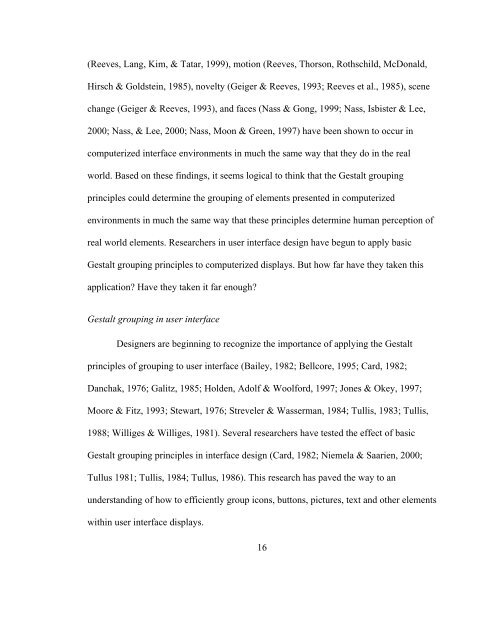The Use of Iambic Pentameter in the
The Use of Iambic Pentameter in the
The Use of Iambic Pentameter in the
You also want an ePaper? Increase the reach of your titles
YUMPU automatically turns print PDFs into web optimized ePapers that Google loves.
(Reeves, Lang, Kim, & Tatar, 1999), motion (Reeves, Thorson, Rothschild, McDonald,<br />
Hirsch & Goldste<strong>in</strong>, 1985), novelty (Geiger & Reeves, 1993; Reeves et al., 1985), scene<br />
change (Geiger & Reeves, 1993), and faces (Nass & Gong, 1999; Nass, Isbister & Lee,<br />
2000; Nass, & Lee, 2000; Nass, Moon & Green, 1997) have been shown to occur <strong>in</strong><br />
computerized <strong>in</strong>terface environments <strong>in</strong> much <strong>the</strong> same way that <strong>the</strong>y do <strong>in</strong> <strong>the</strong> real<br />
world. Based on <strong>the</strong>se f<strong>in</strong>d<strong>in</strong>gs, it seems logical to th<strong>in</strong>k that <strong>the</strong> Gestalt group<strong>in</strong>g<br />
pr<strong>in</strong>ciples could determ<strong>in</strong>e <strong>the</strong> group<strong>in</strong>g <strong>of</strong> elements presented <strong>in</strong> computerized<br />
environments <strong>in</strong> much <strong>the</strong> same way that <strong>the</strong>se pr<strong>in</strong>ciples determ<strong>in</strong>e human perception <strong>of</strong><br />
real world elements. Researchers <strong>in</strong> user <strong>in</strong>terface design have begun to apply basic<br />
Gestalt group<strong>in</strong>g pr<strong>in</strong>ciples to computerized displays. But how far have <strong>the</strong>y taken this<br />
application? Have <strong>the</strong>y taken it far enough?<br />
Gestalt group<strong>in</strong>g <strong>in</strong> user <strong>in</strong>terface<br />
Designers are beg<strong>in</strong>n<strong>in</strong>g to recognize <strong>the</strong> importance <strong>of</strong> apply<strong>in</strong>g <strong>the</strong> Gestalt<br />
pr<strong>in</strong>ciples <strong>of</strong> group<strong>in</strong>g to user <strong>in</strong>terface (Bailey, 1982; Bellcore, 1995; Card, 1982;<br />
Danchak, 1976; Galitz, 1985; Holden, Adolf & Woolford, 1997; Jones & Okey, 1997;<br />
Moore & Fitz, 1993; Stewart, 1976; Streveler & Wasserman, 1984; Tullis, 1983; Tullis,<br />
1988; Williges & Williges, 1981). Several researchers have tested <strong>the</strong> effect <strong>of</strong> basic<br />
Gestalt group<strong>in</strong>g pr<strong>in</strong>ciples <strong>in</strong> <strong>in</strong>terface design (Card, 1982; Niemela & Saarien, 2000;<br />
Tullus 1981; Tullis, 1984; Tullus, 1986). This research has paved <strong>the</strong> way to an<br />
understand<strong>in</strong>g <strong>of</strong> how to efficiently group icons, buttons, pictures, text and o<strong>the</strong>r elements<br />
with<strong>in</strong> user <strong>in</strong>terface displays.<br />
16

















